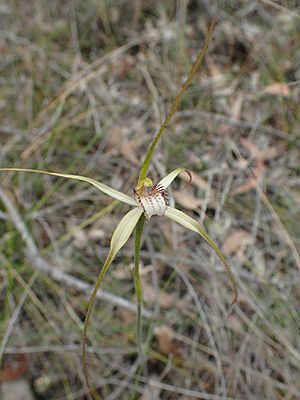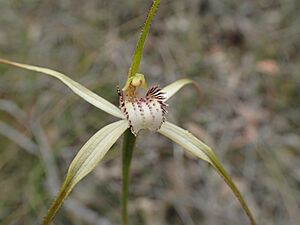Christine's spider orchid facts for kids
Quick facts for kids Christine's spider orchid |
|
|---|---|
 |
|
| Caladenia christineae growing near Rocky Gully | |
| Conservation status | |
| Scientific classification | |
| Genus: |
Caladenia
|
| Species: |
christineae
|
| Synonyms | |
|
|
Christine's spider orchid (scientific name: Caladenia christineae) is a special type of plant. It belongs to the amazing orchid family. This orchid is found only in the south-west part of Western Australia. This means it is endemic there, growing naturally nowhere else in the world!
This unique orchid has one tall, hairy leaf. It can grow up to four small flowers. These flowers are usually white or cream-coloured. You can tell Christine's spider orchid apart from other spider orchids because its flowers are small and don't have a smell. Also, its sepals and petals stand out stiffly.
Contents
What Does Christine's Spider Orchid Look Like?
Christine's spider orchid is a ground-dwelling plant. It lives for many years, even though its leaves might die back in some seasons. It has a special underground part called a tuber. This tuber helps it store food and survive.
Each plant grows a single, hairy leaf. This leaf can be about 6 to 20 centimeters (2.4 to 7.9 inches) long. It is also about 4 to 12 millimeters (0.16 to 0.47 inches) wide.
The plant produces a flowering stem with up to four flowers. Each flower is quite small, about 7 to 10 centimeters (2.8 to 3.9 inches) long. They are also about 6 to 8 centimeters (2.4 to 3.1 inches) wide. The flowers are usually creamy-white or creamy-yellow.
The sepals and petals of the flower spread out widely and are held stiffly. The central part of the flower, called the labellum, is cream-coloured. It has narrow, tooth-like edges. Along the middle of the labellum, there are four or more rows of pale red bumps called calli. These orchids usually bloom in September or October.
How Did It Get Its Name?
The scientific name Caladenia christineae was first officially given to this orchid in 2001. It was described by two scientists, Stephen Hopper and Andrew Brown. They found a sample of the plant near a place called Rocky Gully.
The name christineae was chosen to honor Christine Hopper. She is the wife of Stephen Hopper, one of the scientists who described this beautiful orchid. The description was published in a scientific journal called Nuytsia.
Where Does It Grow?
Christine's spider orchid is found in 28 different groups of plants. These groups are located between Yornup, Bridgetown, and Mount Barker. These areas are part of the Jarrah Forest and Warren regions in Western Australia.
Why Is It Important to Protect This Orchid?
Christine's spider orchid is considered "vulnerable." This means it is at risk of disappearing forever. The Australian government lists it as "vulnerable" under the Environment Protection and Biodiversity Conservation Act 1999. The local Department of Environment and Conservation also calls it "Threatened Flora." This shows it needs special care to survive.
There are several things that threaten this orchid:
- Fires: Fires that happen between May and November can harm the plants.
- Weeds: Other plants, called weeds, can grow too much and take over the orchid's space.
- Salinity: Too much salt in the soil can make it hard for the orchid to grow.
- Clearing: When land is cleared for buildings or farms, the orchid's home is destroyed.
- Road Maintenance: Work done on roads can also disturb where the orchids grow.
- Grazing: Animals eating the plants can also be a problem.
Protecting Christine's spider orchid helps keep our natural world diverse and healthy.



